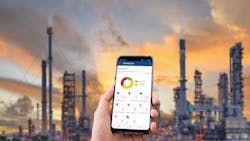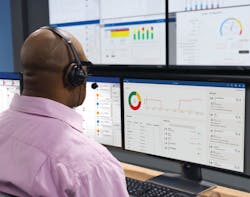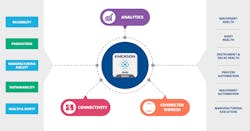In the highly competitive world of modern process manufacturing, data is a critical enabler for success. Organizations can use data from multiple facilities across the enterprise to see the big picture of how their plants perform. Understanding and trending that data can be a key enabler for increasing efficiency to capture the most elusive performance gains — the ones that drive competitive advantage.
However, with many intelligent field devices sending countless pieces of data to machinery health solutions and asset management systems, reliability teams, many of which are quite lean, can quickly become overwhelmed by the flood of data coming in at any given time. Therefore, teams need a way to collect data from their many systems across the enterprise and aggregate it into a common data model where they can track, trend and apply predefined workflows, making it much easier to collaborate among sites and make the most of limited resources.
The solution is enterprise level asset management software. Enterprise asset management tools are designed to bring large amounts of raw data together, standardize and contextualize it, and provide it to the right users at the right time, anywhere in the world they may be located. Using an enterprise asset management solution helps teams better collaborate, without allowing problems like personnel shortages, data drift and IT complexity to get in the way.
Making the most of limited staff
A large process manufacturing organization likely has many systems containing critical data. Among asset management systems, machinery health software and third-party systems, reliability teams may need to collect data from dozens of solutions. Accomplishing this task often means having someone log into each of those systems individually to gather the necessary data, and then find a way to manually aggregate it to make it usable for analysis, often using cumbersome tools like spreadsheets.
For example, consider a large chemical manufacturer with 20 device manager systems managing instruments and valves. Simply connecting to each of those systems and logging in would take a technician several hours to perform routine checks, and that is only if they do not need to move around a facility to access each one. That same data collection would be further complicated if those 20 systems were spread out across a country, or even the globe. Without a dedicated person at each site, few organizations could reliably and regularly collect data.
Today’s reliability personnel have a wide range of responsibilities. Few have the time to sit at a desk waiting to be notified of issues, and even fewer can travel between locations to gather data, all of which takes time away from performing high value tasks. A better solution, and one many organizations are embracing, is to elect a smaller group of expert personnel to collaborate from one or more central locations to manage the entire fleet.
A centralized team can use enterprise asset management software to collate data from every critical data source via modern, open protocols like OPC UA and MQTT. These types of systems deliver critical data to a centralized solution at the enterprise level, where it is standardized, contextualized and distributed to the right users in real time.
A core group of experienced personnel at the enterprise level can then quickly track, trend and monitor the health and performance of every asset in the fleet. Not only does this type of visibility give them a better handle on the overall health of the organization’s assets, it also provides them with the tools they need to collaborate. This allows the team to help less experienced technicians at sites around the globe monitor, maintain and repair their assets more quickly and effectively (Figure 1).
Eliminating data drift
A critical element of making information from many systems more usable is integrating those systems to build more context from the intelligent field, through the edge and into the cloud, as part of a boundless automation architecture. Accomplishing this data democratization at every level means contextualizing the sources in a common data model.
Many plants have been in operation for a very long time. Across those years or decades, many teams regularly added assets, but did not always follow best practices with naming conventions and human machine interface design. Ultimately, these changes can create a complex web of assets which makes it hard for reliability teams to isolate, locate and identify the source of problems. In a global enterprise with hundreds of pumps, it may be difficult to find the precise location of the one with the under-lubricated bearing, especially if the alert necessary for identifying that problem is buried under hundreds or thousands of other, less important alerts.
But in today’s climate of short staff and tight budgets, it is almost unthinkable for many teams to go back and reconfigure an entire fleet worth of assets to create persistence and structure in datasets. Rather than going back through all their instances and changing their structure, today’s forward-thinking reliability experts are using enterprise asset management software to create a common model across the entire fleet.
Such a solution enables teams to see all their instruments and assets in a consistent way, without changing the underlying infrastructure. Instead, the software delivers a top-level workflow across all the different systems to make the data far more usable. The display in the asset management portal empowers reliability personnel to interact with that cohesive, standardized data model in a more intuitive way, empowering them to cut through the noise and quickly pinpoint and resolve problems (Figure 2).
Avoid adding IT complexity
While many organizations today are accessing their reliability data remotely, this is often done through a series of virtual private network (VPN) and remote connections. Such a solution is fine for a single user at one site, but as teams expand to multiple people serving multiple locations, the web of VPNs, disparate information technology (IT) architectures and the many required logins and passwords quickly become unwieldly.
Moreover, as reliability teams add more and more remote connectivity options, security becomes an even greater concern. To properly secure a complex web of custom remote connections, teams quickly find themselves needing to navigate jump servers, demilitarized zones, firewalls and more to reach many of their critical asset management systems, which often reside alongside even more critical real-time control systems.
The best enterprise asset management solutions are built on open architecture principles, making them easier to deploy and secure. Teams looking to implement an enterprise asset management solution should search for software built on IT protocols designed around open architecture principles like MQTT. Such solutions are easier to deploy and interface using proven and secure IT technologies, and they require far less ongoing support than complex VPN architectures.
Closing the loop
The data that comes from asset management and machine health applications is typically raw information, predominantly alerts and alarms. The faster teams can turn that data into actionable information, the quicker they can drive value and improve performance and reliability. Even if a technician can identify and assess an alarm and determine that it is valid, they still need to do something about that alarm to have a positive impact. But if the person who analyzes the alarms is the same person who needs to address each one, it is easy to become overwhelmed.
Modern enterprise asset management software can close the loop on maintenance tasks, making it easier to turn information directly into action. Not only can teams more quickly sort data — by machine, by location, by type and more — but they can often connect the asset management software directly to a maintenance management system, enabling maintenance teams to immediately start a resolution workflow.
In such a configuration, the reliability personnel can immediately create and assign work orders from the same interface (a desktop, or even a mobile device) for any facility in the fleet. They can also track and trend response times and recurrence to identify service bottlenecks and problem assets more easily.
Drive better visibility
Improved performance comes from better awareness, and that awareness stems from better visibility of asset health across the enterprise. Even as staffing becomes more difficult, modern tools make it easy for an organization’s experts to track and trend asset performance so they can make better business decisions and help technicians — located in the same plant or thousands of miles apart — collaborate more efficiently.
Modern enterprise asset management solutions make this possible by collecting open-source information and aggregating it in a common data model. That model helps reliability teams more easily track and trend issues across all their plants and drive actionable information into the hands of the people who need it, wherever they may be across the enterprise.
Erik Lindhjem serves as vice president and general manager of Emerson’s Reliability Solutions business. In this role since June 2021, Erik is focused on driving digital transformation through plant asset management of automation assets and machinery that enables clients to reach top quartile performance.
Emerson




